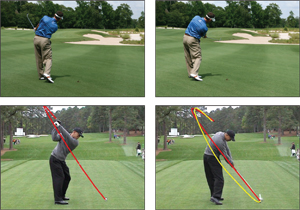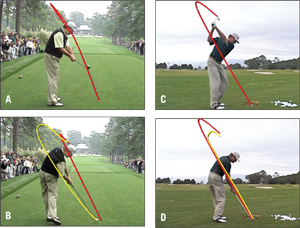 PGA Professional Chris Rowe, the PGA head professional at Whispering Pines Golf Club in Trinity, Texas, is the 2012 Southern Texas Harvey Penick Teacher of the Year.
PGA Professional Chris Rowe, the PGA head professional at Whispering Pines Golf Club in Trinity, Texas, is the 2012 Southern Texas Harvey Penick Teacher of the Year.
I recently came across a new idea to determine how consistent – or inconsistent – a golfer plays based on the gap they create between backswing and downswing. I call this the Swing Gap. The wider the Swing Gap, the more timing and tempo is required. Conversely, a tighter Swing Gap means the player needs less timing to be a consistent ball striker.
The Swing Gap fits with another teaching theory I’ve been using for years: Target Impact and Rounded Impact. Target Impact would be considered by many a two-plane or upright swing – the sort of swing that was required in the days of balata balls and wooden woods, where the right-handed player feels like he’s swinging “toward right field.” Target Impact is determined by where the club points right after impact, and it relies upon timing and hand rotation. In the Target Impact position, it doesn’t matter if the backswing was upright, flat or perfectly on the shoulder plane – all that matters is where the club direction is going after impact.
Rounded Impact is closer to today’s modern golf swing, where the club starts to work immediately left of the target after impact (again, for a righty) and the player relies more on body rotation than hands or timing. Many Tour players today rotate their upper and lower bodies extremely fast to generate clubhead speed, while still swinging as hard left as they want without fear of hitting the ball left. This is possible because today’s golf balls do not spin nearly as much, and because drivers are so much more forgiving.
Tiger Woods is the only player I have seen who actually uses both Target and Rounded Impact positions. He has a Rounded Impact position with his irons and has Target Impact with his driver. This is why he sometimes struggles with the driver, in my opinion: The swing speed he produces is difficult to time properly with his hands. But have you ever seen him hit a bad “stinger” iron shot? He always hits this shot great because he matches his lower and upper body through impact and then moves immediately left.
Knowing which kind of impact a student makes, and what kind of Swing Gap they have, can help you tailor your instruction to their needs.
At top left, the Rounded Impact position is demonstrated with the body and arms making an exaggerated turn through impact. At top right, the Target Impact position is demonstrated with the club moving toward “right field” after impact. Bottom: Tiger Woods has a Target Impact position with the driver.


In looking at the photos above left (A and B), you can see Fred Couples’ swing and notice that he has a large amount of Swing Gap between his backswing (red line) and downswing (yellow line). He has some unique positions in his swing, but because Fred has beautiful tempo he’s still one of the best ball-strikers in the game. Meanwhile, Davis Love III (above right) has almost no Swing
Gap between his backswing and downswing (C and D), and the yellow and red lines of his swing match very closely. This means a player like Davis can move through the ball very fast and not have to rely on timing as much to play well.
The Swing Gap doesn’t always put a golfer in one certain impact position, but my experience shows that the wider Swing Gap players tend to be Target Impact swingers. For these students, I focus on getting their weight to transfer to their back foot on the backswing, making a full shoulder turn with their back facing the target, being smooth at the transition to the downswing, and swinging to right field (for righties) with less hip rotation.
Tighter Swing Gap players more often fall into the Rounded Impact category. For these students, weight transfer does not have to be as complete in the backswing. But the downswing should be aggressive, with the hips and shoulders turning toward the shortstop position (for righties) and the player staying in their posture as long as possible, using very little hands at impact.
Using video to show a student their Swing Gap and helping them understand what impact category is best for them is a great way for them to learn more about their golf swing. It also will show them how well you understand their individual swing, and help you build a long-term instruction relationship with them.


